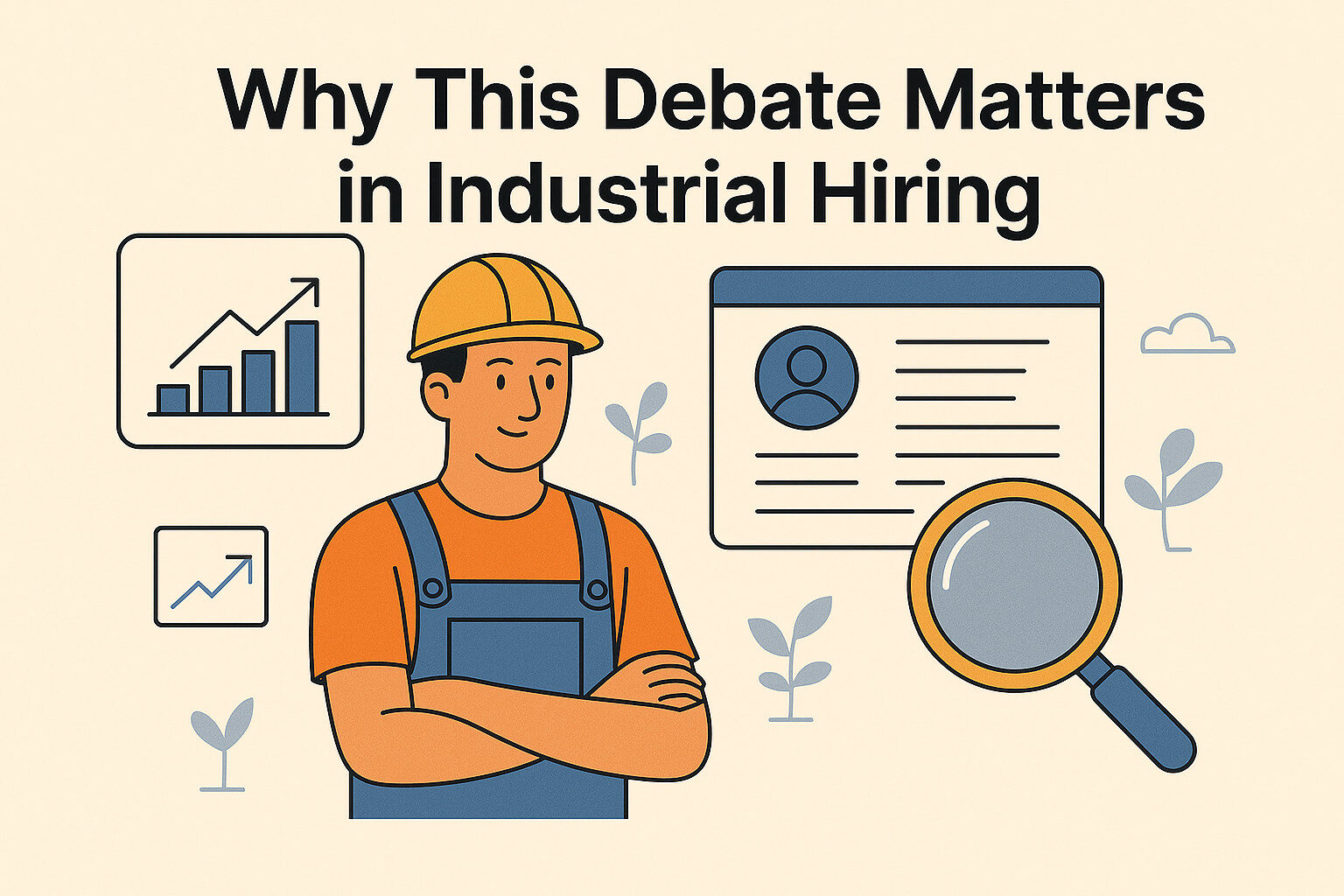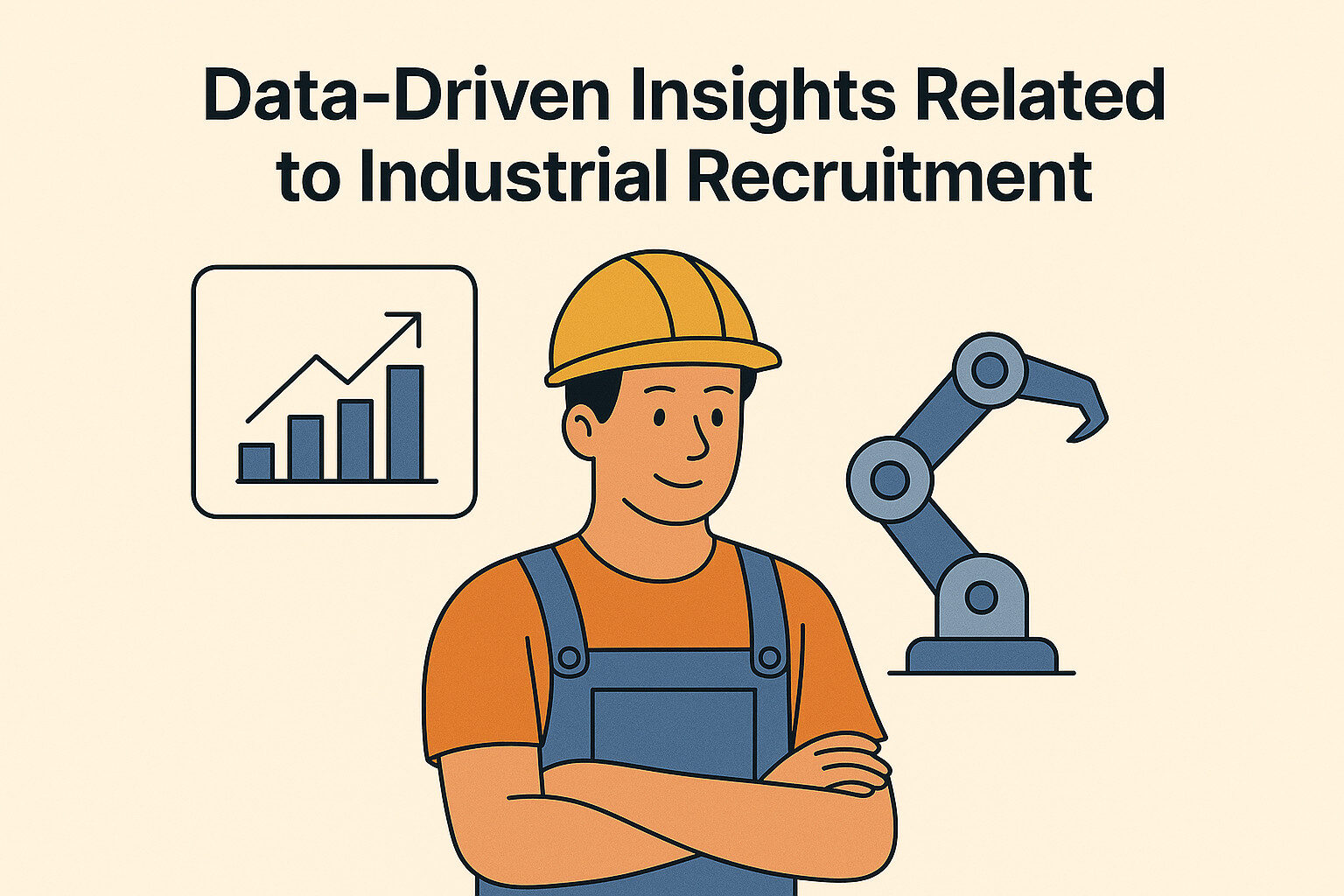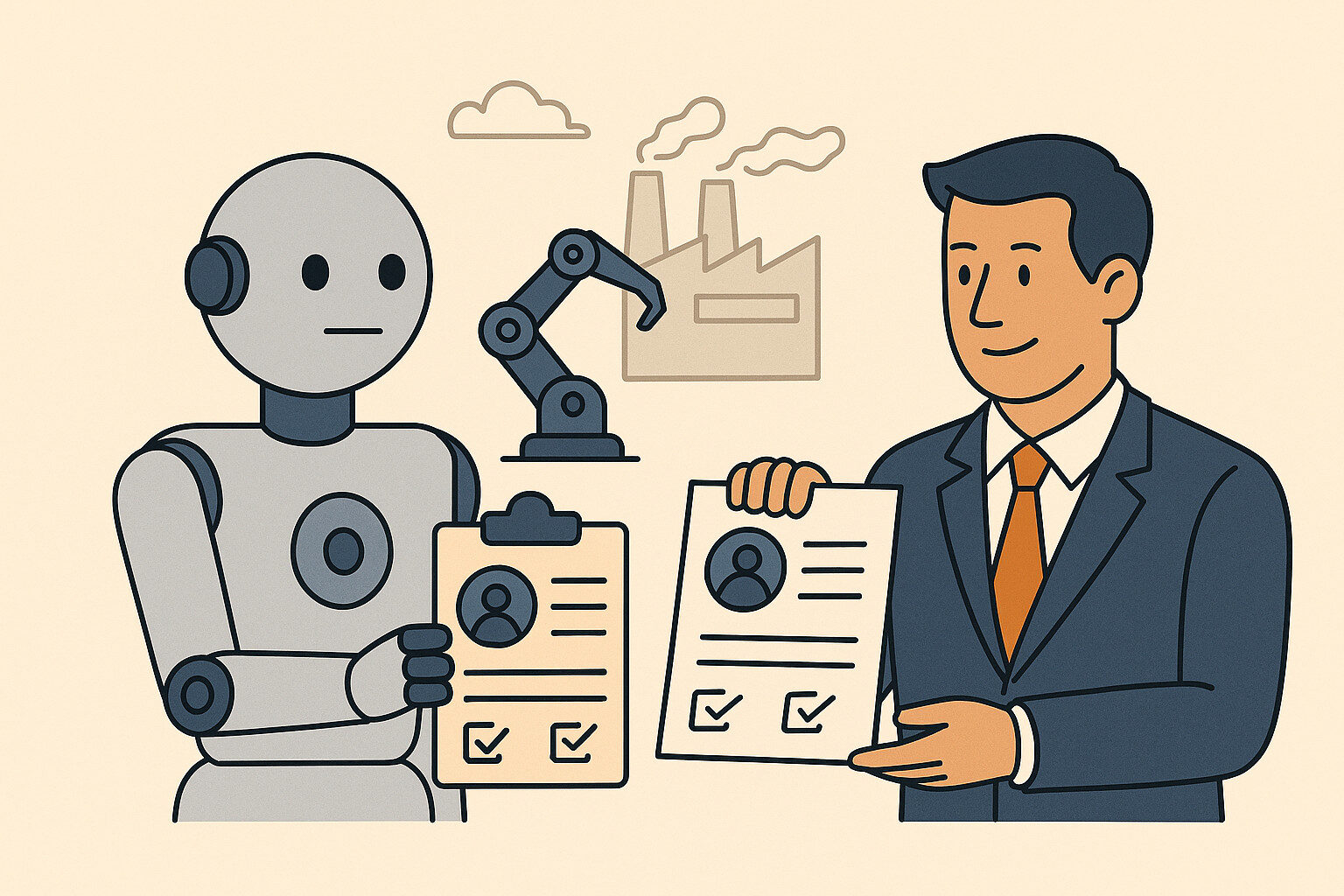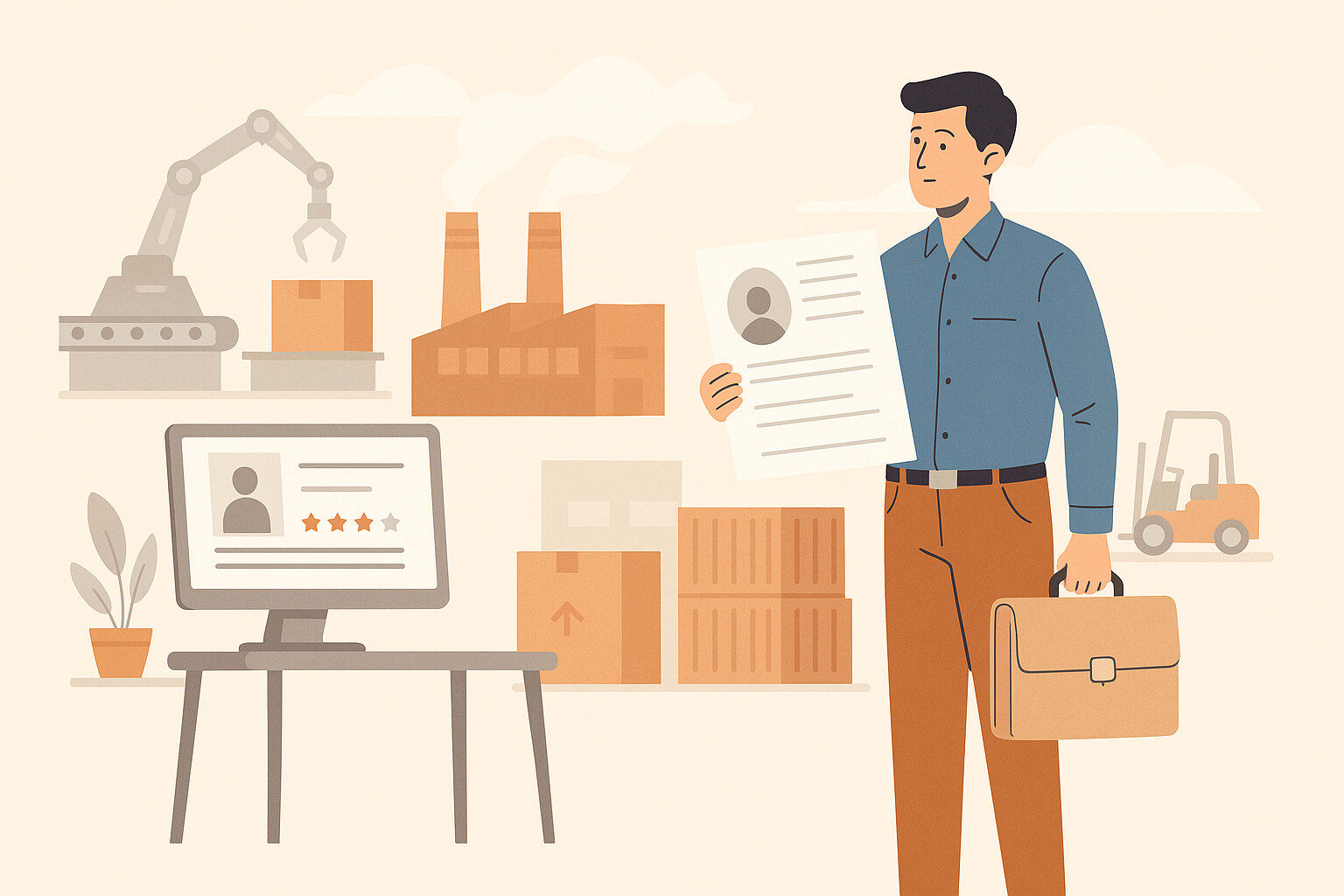In an era where the industrial workforce is under pressure from automation, generational shifts, and a tightening talent pool, companies must decide: Which approach will deliver better results AI vs human recruiters industrial hiring? Whether you’re staffing manufacturing lines, maintenance teams, supply-chain logistics, or engineering operations, this question matters. This article examines both sides, brings in data, explores the industrial context, and ultimately argues that the real “win” comes from a hybrid model when human experience and AI capability are combined.

Why This Debate Matters in Industrial Hiring
Industrial recruitment (manufacturing, assembly, maintenance, heavy logistics) has unique challenges:
- High volume of roles with varying skill levels, ranging from machine operators to automation specialists.
- A shortage of qualified technical and maintenance talent across the U.S. manufacturing sector.
- The need for fast ramp-up and minimal downtime: un-filled or mis-hired roles can impact throughput, quality, safety and costs.
- An evolving skillset: the “industrial worker” now often must interface with robotics, IIoT systems, digital dashboards and predictive maintenance tools.
Given all this, optimizing recruitment becomes a strategic imperative and the question of using AI versus traditional human recruiters becomes not just operational but strategic.
From the data side, the global AI recruitment market is already valued at USD $661.56 million in 2023 and projected to reach $1.12 billion by 2030. Moreover, studies show that AI recruitment platforms can reduce shortlisting time by up to 75% and double hire-to-shortlist ratios. In short: efficiency gains are real.
However, when you look at what industrial hiring requires (culture fit, equipment familiarity, safety orientation, team cohesion), human recruiters bring advantages that AI alone may not replicate. So the question isn’t simply “which wins?” but rather “which approach wins for which part of the process and how to integrate both.”
Strengths of AI in Industrial Recruiting
Here are key areas where AI demonstrates strong advantages, especially in high-volume industrial recruitment.
1. Speed & Scale
AI tools can screen resumes, evaluate skills, parse keywords and match candidates far faster than humans. For example, one source claims AI recruiters can process 10× the volume of human recruiters and result in ~76% cost savings. In an industrial setting where you may have hundreds or thousands of applicants for machine-operator or technician roles, that speed matters.
2. Consistency & Reduction of Manual Bias
AI applies the same criteria across all candidates (if configured correctly), reducing variation due to fatigue, mood or human error. As one blog notes: “AI recruitment platforms … reduce bias through structured algorithms and deliver up to a 75% reduction in time-to-shortlist.” In industrial talent pools where mechanical aptitude, certifications, and safety training records may vary, this consistency is beneficial.
3. Cost Efficiency
Because AI tools scale without linear headcount growth, they offer cost advantages. The industry estimates show a large cost differential between human recruiter resources vs. AI systems. For industrial firms managing many roles, lowering cost‐per‐hire is meaningful.
4. Data-Driven Insight & Analytics
AI systems bring dashboards, predictive analytics, and data modelling capabilities that help forecast hiring needs, identify sourcing bottlenecks, and measure metrics like time-to-fill, candidate conversion, skill match rates. In industrial hiring where downtime is expensive, this visibility helps.
5. High-Volume First Screening
In large‐scale hiring (e.g., manufacturing line expansions, shift hires), AI is particularly useful for “first pass” screening: parsing certifications (e.g., welding, forklift certification), verifying experience, and routing candidates to next steps.
Strengths of Human Recruiters in Industrial Hiring
Despite the clear advantages of AI, human recruiters continue to bring critical strengths especially in the context of industrial hiring.
1. Relationship Building & Candidate Experience
Human recruiters excel in understanding candidate motivations, managing expectations, negotiating offers, and building long-term pipelines. Candidates in industrial roles often value clarity about shifts, safety culture, equipment, career paths and nuances better communicated by humans.
2. Assessing Context, Fit & Soft Skills
While AI may handle parsing and matching, humans can assess fit: will this candidate thrive in a high-pace manufacturing environment? Do they have situational awareness of safety hazards? Can they collaborate in teams or follow instruction manuals and process flows? These soft and contextual skills matter in industrial environments.
3. Handling Complexity, Exceptions & Emerging Roles
Industrial hiring increasingly involves roles that combine mechanical, digital and robotics skills (e.g., an automation technician). Human recruiters can interpret job-profiles, clarify ambiguous requirements, and adapt processes. A rigid AI may struggle with novel or hybrid role definitions.
4. Judgment & Stakeholder Management
Human recruiters interface with hiring managers, plant operations, engineering, union or non-union environments, and need to translate workforce strategy into talent actions. They interpret market conditions (skill shortages), negotiate compensation, adapt to unforeseen logistics. These are human strengths.
5. Candidate Trust & Brand Representation
A strong employer brand in industrial hiring is built through authenticity, tours, human stories, supervisor interactions, something human recruiters convey better than chatbots. In addition, for specialised roles, the human touch helps candidates feel valued and engaged.
Limitations of Both Approaches (and Industrial Hiring Risks)
AI Limitations
- Data & Bias: AI is only as good as the historical data. If your past hires were heavily skewed (gender, experience, background), AI may replicate bias.
- Lack of Context: AI might not grasp unusual candidate backgrounds, non-traditional experience, or roles in production that require adaptability beyond keywords.
- Candidate Perception: Some applicants might feel alienated if they have no human interaction. Studies show mixed candidate sentiment around AI-led processes.
- Ethical & Regulatory Risk: In hiring, AI needs transparency, auditability and fairness. Industrial firms may face regulatory oversight if AI leads to discrimination.
Human Recruiter Limitations
- Scale & Cost: Humans can’t handle thousands of applicants per hour; cost and time escalate.
- Variability & Fatigue: Human judgment can vary; bias, burnout or incomplete screening can affect outcomes.
- Limited Pre-Screening Efficiency: Humans may spend excessive time filtering unqualified resumes or missing qualified candidates because of volume.
Industrial Hiring Risks
In industrial settings these limitations translate into tangible risks:
- Wrong hire leads to safety incidents, downtime, quality failure.
- Slow fill leads to production delays and cost overruns.
- Poor candidate experience leads to brand damage and lower future applications.
- Skill mismatch leads to costly training and attrition.
A Hybrid Model: Best of Both Worlds in Industrial Recruitment
Rather than choosing AI or human recruiters exclusively, the emerging consensus is a hybrid model using AI for what it does best, human recruiters for what only humans can do. This approach is particularly suited for industrial recruitment.
How a Hybrid Model Works
- AI in Early Funnel: Use AI to parse resumes, conduct initial assessments (mechanical aptitude, certification verification, digital skills screening), rank candidates, and schedule interviews.
- Human Recruiter in Later Funnel: Once a candidate is assessed as “qualified” by AI, human recruiters take over for deeper interviews, culture/fit evaluation, on-site tours, negotiations, and final decision making.
- Continuous Feedback Loop: Use data from the human stage (hire outcomes, retention, performance) to refine AI models, feeding back into screening criteria and improving predictive accuracy.
- Transparent Governance & Ethics: Ensure the AI tools deployed are audited, bias-checked, transparent. Human recruiters should oversee exceptions and flagged cases.
- Blend Metrics & Qualitative Insight: Track KPI’s (time-to-fill, cost-per-hire, quality-of-hire, retention) and enrich with qualitative feedback: candidate experience, plant supervisor satisfaction, onboarding ramp performance.
Why This Model Suits Industrial Hiring
- Since industrial hiring often involves high volume roles (operators, assemblers) andspecialist roles (automation technicians, maintenance engineers), you need tools that scale plus human judgment.
- The need for safety, culture, physical environment fit means you cannot rely solely on data; the human portion ensures real-world fit.
- Data from operations (downtime, productivity, attrition) can feed into AI models, improving screening for future roles in the plant.
- Using AI reduces cost/time for generic roles, freeing human recruiters to focus on strategic hires (managers, technical specialists).
Applying This to Your Industrial/Manufacturing Context: Practical Steps
Step 1: Audit Your Current Process
- Map your recruitment funnel: sourcing → screening → interview → offer → onboarding → ramp-up → retention.
- Collect and benchmark key metrics: time-to-fill, cost-per-hire, quality-of-hire (first-90 days performance), 12/24 months retention.
- Identify roles with high volume vs roles with high skill/cost/risk.
Step 2: Define Where AI Makes Sense
- For high-volume roles (e.g., machine operator, warehouse technician), implement AI screening to filter by required certifications (forklift, welding, CNC), mechanical aptitude test scores, and availability.
- Define criteria in consultation with operations and safety to ensure downstream fit.
- Choose AI tools with transparent logic and bias mitigation.
Step 3: Define Human-Centric Touchpoints
- For specialist/mission-critical roles (automation technician, maintenance engineer, production manager), human recruiters should lead.
- Use human front-end for candidate tours of the plant, safety culture discussions, career path conversations, and fit assessments.
- Integrate structured behavioral interviews anchored to role scorecards.
Step 4: Integrate Data & Feedback Loops
- Feed performance outcomes (e.g., retention, productivity, safety incidents) back into recruitment screening criteria and AI tool parameters.
- Monitor candidate experience (e.g., drop-off rates, NPS) and adapt both AI and human touchpoints.
- Use dashboards to highlight gaps: e.g., if AI-screened hires have higher early-turnover, adjust screening logic; if human-recruited hires cost more, refine hand-off points.
Step 5: Train your Team & Communicate Change
- Educate human recruiters about how AI tools function, how to interpret output, and the importance of oversight.
- Clearly communicate to candidates where AI is used in process (transparency builds trust).
- Ensure operations leaders understand the value of combining AI + human, and are aligned on metrics and outcomes.
Step 6: Monitor Legal & Ethical Compliance
- Confirm that your AI tools meet privacy, bias, and fairness requirements (especially in the U.S. regulatory environment).
- Ensure human oversight of AI decisions, especially for finalists, to avoid unintentional discrimination.
- Document the process so you can audit and defend decisions if needed.

Data-Driven Insights Specific to Industrial Recruitment
- 87% of companies now use AI-driven tools in recruitment.
- 35% of recruiters worry that AI may exclude candidates with unique skills and experiences.
- A study showed candidates who underwent AI-led interviews had a 53.12% success rate in subsequent human interviews vs 28.57% for candidates screened traditionally.
- The AI recruitment industry is projected to grow at a CAGR of 6.78% from 2023–2030.
In an industrial context, this data means:
- You can expect significant efficiency gains by applying AI in early screening.
- But you must guard against excluding non-traditional backgrounds (important in industrial where many technicians come from vocational, second-career, or military backgrounds).
- Tracking your outcomes is essential: If AI screenings lead to higher turnover in your specific roles (e.g., machine operators), you need to adjust.
Example: Manufacturing Plant Recruitment Strategy
Imagine a U.S. manufacturing plant planning to hire 300 new machine operators and 20 automation technicians in the next 12 months.
- Volume roles (300 operators): Use AI to screen applicant pools for certifications (CNC, forklift), mechanical aptitude test, shift availability, and safety compliance. Human recruiter review begins at a shortlist of 500 from 2,000 applicants.
- Specialist roles (20 automation techs): Human recruiters lead with domain expertise; AI supports by gathering candidate data and presenting matched profiles.
- Outcome tracking: Time-to-fill for operator roles reduced from 45 days to 25 days; cost-per-hire reduced by 22%. For automation techs, human-led process maintained but candidate experience improved due to faster shortlisting.
- Feedback loop: 90-day retention for operator roles improved by 15% when AI screening included criteria derived from previous high-performers (mechanical aptitude + 1 year safety‐incident-free history).
- Hybrid model validated: Plant leadership remains comfortable because human recruiters retained oversight for final selections and onboarding, preserving cultural and safety fit.
Future Outlook: What the Industrial Recruiter Should Do
- Stay current on how AI tools evolve new capabilities in natural language, video analytics, skills assessment will increasingly impact industrial hiring.
- Embrace the mindset of augmentation, not replacement. The recruiter’s role will evolve: less time on administrative screening, more on strategic talent planning, candidate experience, workforce strategy.
- Adopt a data-first attitude: recruitment should sit alongside operations data (productivity, downtime, attrition, safety incidents) so hiring decisions are tied to business outcomes.
- Develop flexibility: as industrial roles shift (automation, robotics, predictive maintenance), your talent profile will change and your recruitment tools (AI + human) must adapt.
- Prioritize ethics and fairness: especially important in industrial recruiting where you may hire from non-traditional backgrounds, veterans, second-career entrants ensure your AI tools don’t unfairly filter these out.
Conclusion: The Real Winner in Industrial Hiring
In the debate “AI vs human recruiters industrial hiring,” the real winner is neither alone it’s the hybrid model. AI delivers unmatched speed, consistency, and data-driven scale. Human recruiters deliver insight, judgment, relationship management and cultural fit. In industrial settings, where safety, productivity and team fit matter deeply, combining both gives you the best recruitment outcome.
For your industrial organisation, this means:
- Use AI smartly in early stages especially high volume, lower skill roles.
- Ensure human recruiters retain oversight for critical hires, culture fit, and onboarding.
- Track outcomes rigorously time-to-fill, cost-per-hire, quality-of-hire, retention and feedback into your tools and processes.
- Build trust with candidates by being transparent about AI use and maintaining human connection.
If you execute this way, you’ll turn recruitment from a cost centre into a strategic driver. You’ll fill roles faster, hire better, retain more, and support operational excellence. In the rapidly evolving industrial labour environment of the U.S., that’s a winning strategy.




